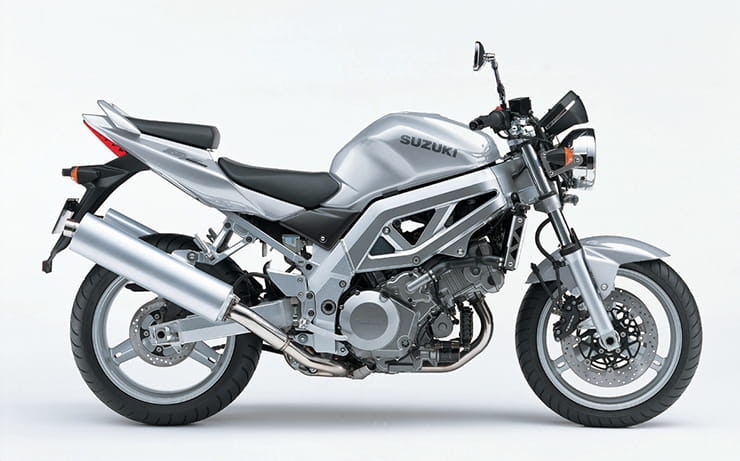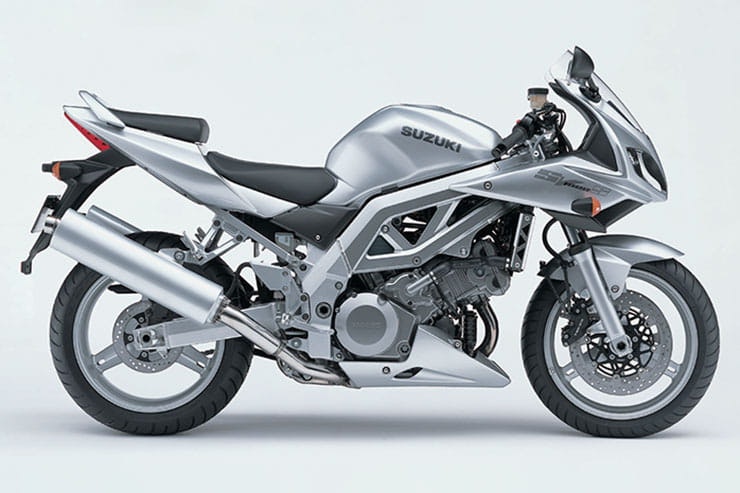Suzuki SV1000S and SV1000 (2003-2008): Review & Buying Guide
By Jon Urry
Massively experienced road tester
03.05.2023
Price: £1600-£4500 | Power: 123bhp | Weight: 208kg | Overall BikeSocial Rating: 3/5
Arriving in 2003, on paper the SV1000S and its naked SV1000 sibling should have been huge sellers for Suzuki. All the right ingredients were there for success – a storming V-twin engine, a natural progression up for riders from the wonderful (and best-selling) SV650 models, good handling and an impressively low price tag. What could go wrong? As it turned out, quite a lot. Hampered by fairly uninspiring looks, dubious build quality and a general lack of interest from the buying public, the SV1000 models never really took off. Maybe if Suzuki had given them a bit more of a premium feel they would have done better but they targeted the big SV at the lower end of the market and sadly these buyers didn’t materialise and those who did have a bit more cash to splash opted for more premium rival models instead. Nowadays the SV1000 remains a very low priced option and to be fair, if you buy a good one it is a decent bike and great value for money. The engine is a peach, the chassis easily upgraded and in naked SV1000 form it has a bit of welcome attitude and quite cool looks. The problem, however, is that there are quite a few tatty examples out there so you need to buy with caution...
Suzuki SV1000S and SV1000 (2003-2008) Price
Costing just £6399 for the half-faired SV1000S and £5650 for the naked SV1000 in 2003, the SV was an absolute bargain – in fact, it cost just £2000 more than the SV650! As the years passed it went up slightly with the full-faired model adding a few quid to the price tag but it never went that high and as a result, used prices remain low. You can pick up a very tatty SV1000 for under £2000 but you get what you pay for and it will have a lot of corrosion in the usual areas. Spend closer to £2500 and you will get a far tidier example with mid-20,000 miles on its clocks, which is acceptable. Very tidy bikes go for £3000 with dealers generally asking between £3000 and £4000 for any with under 20,000 miles on their clocks. The naked SV1000 didn’t sell as well as the half-faired S, so are a bit harder to locate, but don’t pay any extra for a naked bike compared to the half-faired one. And if you are seriously considering buying a fully-faired one, buy a dedicated fully-faired model rather than add an aftermarket half-fairing (you are unlikely to locate an original Suzuki fairing) to an S as the colours will match up perfectly! Later in the SV’s life a limited edition SV1000SZ was released with GSX-R-style paint, extra power and a full fairing, which tends to command a few quid more than stock faired bikes, and there was even an official ‘café racer’ model – although good luck finding one of those!
Superb V-twin engine
Good all-rounder
Decent reliability, low price tag
Dubious build quality
It’s not terribly exciting
The look is a bit dated, especially the S model
Engine and Performance
Yes, the SV1000 runs a TL1000S-derived engine but it is quite removed from the original version (Suzuki claimed over 300 changes) and is far more developed and reliable as a result with a beefed-up clutch to prevent the old TL clutch issues cropping up. But it was also less powerful (originally 112bhp compared to the TL’s 125bhp), which was a bit of an issue, although the peak torque figure was comparable. Suzuki did actually update the SV and its engine was improved in 2005 (look for a black frame) with a higher compression ratio, larger throttle bodies and a lighter flywheel to improve both power and acceleration, taking it up to 118bhp. The ‘special edition’ SV1000SZ also gained 5bhp peak power, not that you would spot it. So does it still feel like a TL engine? Not really – which isn’t necessarily a bad thing.
Relaxed and easy-going, the SV’s motor is quite far removed from the more aggressive TL lump. Much like its smaller SV650 sibling, the SV1000 is really easy bike to live with and retains that unassuming nature that makes the SV650 so charming. But is this what you want in a litre V-twin? That’s debatable and the SV1000 is often criticised for being too soft and a bit underpowered, especially in naked form where you expect a bit more balls. If you like the feel of a V-twin motor but don’t want one that is continually straining at its leash, the SV1000 will certainly appeal. If, however, you want a bit of spice, the SV1000 fails to get your blood rushing in the same was as some naked V-twin rivals such as the KTM 990 Super Duke or Ducati Monster or Streetfighter range. With this in mind it tends to suit life as a half or full-faired bike better, so treat it as a relaxed do-it-all much like a Honda FireStorm or Aprilia Falco and you won’t be disappointed.
When it comes to reliability the SV is mechanically fairly strong but you do need to be a touch wary. The motor can sip a bit of oil between services (every 4000 miles) and if run too low this can have disastrous consequences. Always listen out for a bit of a rumble on start-up and check the oil level. The magnets on the stator are starting to work loose as age makes their glue degrade, so it is worth keeping an eye on this area, and if your battery starts to go flat regularly, assume a new unit is required (between £60 and £100). Although ideally don’t let it get this far as if a magnet does drop off, it can write-off a motor... If the engine feels overly lumpy, a cam-position sensor may have failed or the throttle bodies just aren’t well balanced – neither of which is a particularly tricky fix with a sensor costing roughly £100 new from Suzuki or £60 for a pattern part. A miss-fire is generally due to the front cylinder’s spark plug cap or HT lead getting damaged, again these are fairly easy and cheap to replace. The studs that connect the exhaust header to the front cylinder corrode terribly and seize, which is a nightmare should the gasket start to blow an require replacing, so check what they look like and feel for any signs of gas escaping. And finally there is the clutch, which although stronger than the TL’s unit can develop a judder which usually means the basket is on its way out and will need replacing...
Suzuki SV1000S and SV1000 (2003-2008) Handling & Suspension
The SV1000S and SV1000 were never touted as sportsbikes but that didn’t stop potential buyers assuming that Suzuki would have made a bit more effort in the handling area. Which was another issue when the bike was launched...
Decidedly budget-looking, the SV may have fully-adjustable suspension (and, thankfully, a monoshock!) but with conventional forks instead of inverted items there is a definite hint of cost-cutting about – both visually and in terms of their quality (flaking paint a common complaint) and the same criticism could be levelled at the brakes. It doesn’t take long for rust to form on the brake rotors and that makes an SV look decidedly second-hand very quickly, which is a shame as the calipers themselves perform well. But, looks aside, how does the SV ride?
Out on the open road the SV isn’t a bad handling bike but it does feel a touch long as Suzuki opted for stability over agility. You don’t ride an SV1000 and return surprised at just how agile and fun it is as you do on an SV650, instead you return fairly nonplussed. It’s a bit of a beige bike that fails to excel in any one area but, that said, it doesn’t disappoint either. Treat its handing as workmanlike and you won’t feel let down.
Suzuki did upgrade the SV’s chassis in 2005 and alongside a black frame and swingarm arrived revised suspension damping rates, not that they really change the ride quality to a noticeable degree. Oddly, in 2004 Suzuki also swapped the SV’s subframe for an aluminium unit from the previous model’s steel, lowered its pegs and lengthened the swingarm – quite why is a bit of a mystery.
When buying used, your main worry is build quality. All of the SV’s fasteners corrode horribly, the discs rust, the radiator corrodes (check for leaks), the paint finish isn’t brilliant and crash damage is quite common. It’s a cheap and cheerful bike and as a result, often doesn’t get the love and attention it requires to look good. Buy a good one and treat it with a bit of care – and anti-rust spray!
Comfort & Economy
The SV1000 is actually quite a comfortable bike with high bars and fairly low pegs, which is good. It also has decent pillion provisions, so you can certainly treat one as a sports tourer. Annoyingly there is no fuel gauge, only a warning light, but that’s not a huge drama and you can always use the trip as a guide.
In terms of economy, you can expect low 40s mpg figures and a realistic tank range of just over 150 miles, which is acceptable but not brilliant. Obviously, if you want to cover distance buy the half-faired S model over the naked SV1000, and ideally get the fully-faired version for the maximum weather protection.
Suzuki SV1000S and SV1000 (2003-2008) Equipment
Decidedly lacking in equipment, the SV has no mod-cons – not even a fuel gauge so don’t get your hopes up! When it comes to accessories, with the SV you get two types of owner – commuters and Sunday riders. Commuters often add luggage, a taller screen and heated grips to the SV1000S while weekend riders go for a pillion seat cover and loud pipe. Ideally you want a weekend bike as the level of finish on the SV means, visually at least, it doesn’t stand up very well to being used in poor weather conditions.
By now a set of braided lines is worth adding to the brake system as the original rubber items will be past their best and that’s a safety issue, so make this your first addition if your bike is still on OE lines.
*900ss shown
Suzuki SV1000S and SV1000 (2003-2008) Rivals
Owners of the SV1000S tend to be those looking for a solid all-rounder at a bargain price, which the SV most certainly is. Generally they aren’t full-on sportsbike fans and they like to take a pillion. The SV1000, however, often attracts an owner who likes to modify their bike and as such the naked bike tends to be the one with a loud pipe and a few accessories added.
Honda FireStorm (1997-2005) | Approx Price: £1200-£3000
Power/Torque: 97bhp/64lb-ft | Weight: 193kg
Aprilia Falco (1999-2005) | Approx Price: £1000-£2800
Power/Torque: 118bhp/70.5lb-ft | Weight: 190kg
Ducati 1000SS (2002-2006) | Approx Price: £3000-£5500
Power/Torque: 84bhp/70lb-ft | Weight: 188kg
Suzuki SV1000S and SV1000 (2003-2008) Verdict
The SV1000S, and to a lesser degree the SV1000, are bread and butter bikes. Built to a budget, they aren’t that flash aren’t that sexy and arguably aren’t that exciting to ride either. However they are reliable, cheap and do all that is asked of them with no fuss or drama. Get a good one, ensure it stays that way through regular cleaning and they are a solid machine that won’t let you down.
Suzuki SV1000S and SV1000 (2003-2008) – Technical Specification
Looking for motorcycle insurance? Get a quote for this motorbike with Bennetts bike insurance

